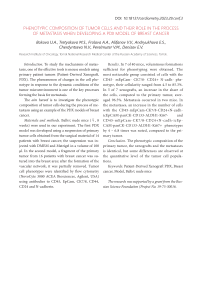Phenotypic composition of tumor cells and their role in the process of metastasis when developing a PDX model of breast cancer
Автор: Bokova U.A., Tretyakova M.S., Frolova A.A., Alifanov V.V., Andryukhova E.S., Cherdyntseva N.V., Perelmuter V.M., Denisov E.V.
Журнал: Cardiometry @cardiometry
Рубрика: Conference proceedings
Статья в выпуске: 29, 2023 года.
Бесплатный доступ
To study the mechanisms of metastasis, one of the effective tools is mouse models using primary patient tumors (Patient-Derived Xenograft, PDX). The phenomenon of changes in the cell phenotype in response to the dynamic conditions of the tumor microenvironment is one of the key processes forming the basis for metastasis. The aim hereof is to investigate the phenotypic composition of tumor cells during the process of metastasis using an example of the PDX models of breast cancer.
Patient-derived xenograft pdx, breast cancer, model, balb/c nude mice
Короткий адрес: https://sciup.org/148327375
IDR: 148327375 | DOI: 10.18137/cardiometry.2023.29.conf.3
Текст статьи Phenotypic composition of tumor cells and their role in the process of metastasis when developing a PDX model of breast cancer
Materials and methods . Balb/c nude mice ( $ , 8 weeks) were used in our experiment. The first PDX model was developed using a suspension of primary tumor cells obtained from the surgical material of 14 patients with breast cancer; the suspension was injected with DMEM and Matrigel in a volume of 100 μl. In the second model, a fragment of the primary tumor from 16 patients with breast cancer was sutured into the breast area; after the formation of the vascular network, it was partially removed. Tumor cell phenotypes were identified by flow cytometry (NovoCyte 3000 ACEA Biosciences, Agilent, USA) using antibodies to CD45, EpCam, CK7/8, CD44, CD24 and N-cadherin.
Results . In 7 of 40 mice, voluminous formations sufficient for phenotyping were obtained. The most noticeable group consisted of cells with the CD45- mEpCam- CK7/8- CD24+ N-cadh- phenotype, their cellularity ranged from 4.5 to 85.3%. In 5 of 7 xenografts, an increase in the share of the cells, compared to the primary tumor, averaged 96.5%. Metastasis occurred in two mice. In the metastases, an increase in the number of cells with the CD45-mEpCam-CK7/8-CD24+N-cadh-icEpCAM-panCK-CD133-ALDH1-Ki67- and CD45-mEpCam-CK7/8-CD24+N-cadh-icEp-CAM-panCK-CD133-ALDH1-Ki67+ phenotypes by 4 – 6.8 times was noted, compared to the primary tumor.


